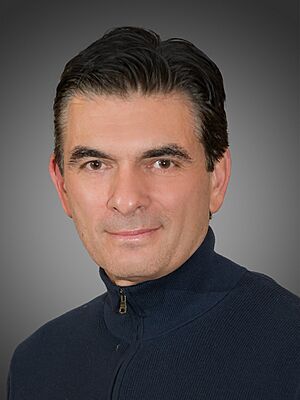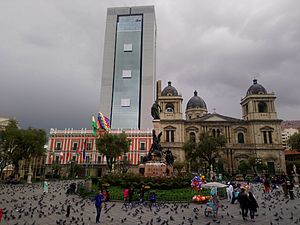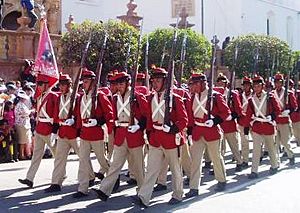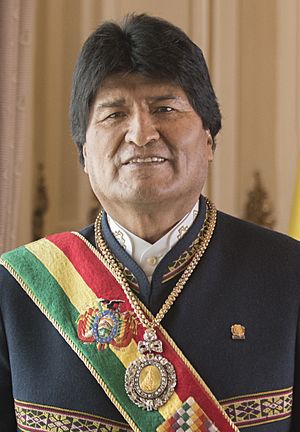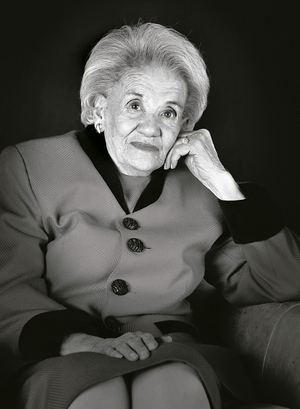President of Bolivia facts for kids
Quick facts for kids President of thePlurinational state of Bolivia |
|
|---|---|
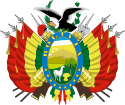
Coat of arms of Bolivia
|
|
| Style | The Most Excellent (Formal) His Excellency (Diplomatic) |
| Residence | Casa Grande del Pueblo |
| Seat | La Paz |
| Nominator | Plurinational Electoral Organ |
| Appointer | Direct popular vote (two rounds if necessary) |
| Term length | Five years,
renewable once
|
| Constituting instrument | Constitution of Bolivia (2009) |
| Inaugural holder | Simón Bolívar |
| Formation | June 24, 1825 |
| First holder | José Mariano Serrano |
| Deputy | Vice President of Bolivia |
| Salary | 24,251 bolivianos/US$3,561 per month |
| Website | www.presidencia.gob.bo |
The President of Bolivia is the most important leader of the country. This person is both the head of state (representing Bolivia to the world) and the head of government (leading the country's daily operations). The president is also the top commander of Bolivia's armed forces.
People in Bolivia vote directly to choose their president. A president serves for five years and can be re-elected only once. If no candidate gets enough votes in the first round, the two candidates with the most votes compete in a second election.
Currently, Rodrigo Paz Pereira is the 68th President of Bolivia. He began his term on 8 November 2025.
Contents
How Bolivia's Presidency Began
The First Leaders of Bolivia
Bolivia became an independent country on 6 August 1825. Simón Bolívar, a famous leader, was named the head of state. There's a friendly debate among historians about whether Bolívar or Antonio José de Sucre was truly the first president.
Some historians say Sucre was the first because he was called "president" in official papers and helped create Bolivia's first Constitution in 1826. Others argue that Bolívar was the first because he was given "Supreme Executive Power" right after independence. Today, most people agree that Simón Bolívar was Bolivia's first president.
Changes to the President's Role
The first Constitution in 1826 said the president could serve for life! This changed in 1831 under President Andrés de Santa Cruz. After that, presidents served for four years and could be re-elected many times.
The 2009 Constitution and New Rules
The 2009 Constitution brought big changes. Bolivia officially became the "Plurinational State of Bolivia." President Evo Morales was the last president of the "Republic" and the first of the "Plurinational State."
This new Constitution also changed the presidential term to five years. It set a limit of two terms, meaning a president could only be re-elected once. There was an attempt in 2016 to remove this term limit, but voters decided to keep it. Later, in 2017, a court ruled that elected officials could run for office without limits, based on human rights ideas.
Before 2009, if no one won a majority of votes, the country's lawmakers would choose the president. This sometimes meant that a candidate who didn't win the most votes from the people became president. The 2009 Constitution changed this to a two-round system. Now, if no one wins enough votes in the first round, the top two candidates have a second election.
How Presidents Serve and Leave Office
When a President's Term Ends Unexpectedly
Throughout Bolivia's history, some presidents have faced unexpected or difficult ends to their time in office. Some passed away while serving, and others faced tragic circumstances. This shows the challenges leaders sometimes face.
Who Takes Over? The Line of Succession
If a president cannot continue their duties, the vice president takes over. If the vice president also cannot serve, the president of the Senate steps in. If none of these leaders are available, the president of the Chamber of Deputies takes charge. In this last case, new elections must be held within 90 days.
Historically, there have been times when the vice president's role didn't exist or was empty. During these times, other officials, like the President of the Senate, would be next in line.
Interim and Acting Presidents
Sometimes, a president leaves office before their term is over, perhaps due to resignation or other reasons. In such cases, an interim president steps in. Their main job is to lead the country until new elections can be held and a new president is chosen. Leaders like Lidia Gueiler Tejada and Jeanine Áñez served as interim presidents.
An acting president (called Presidente en ejercicio in Spanish) is a temporary role. This happens when the president is briefly unable to perform duties or is out of the country. The acting president takes on the responsibilities for a short time. In 2012, Senate president Gabriela Montaño became the first woman to serve as acting president.
Where the President Lives and Works
The official home and workplace of the President of Bolivia is the Casa Grande del Pueblo. This name means "Great House of the People." It is located in La Paz, which is Bolivia's administrative capital. This modern building was opened in 2018 and houses the president and many government offices.
Before 2018, the president's official residence was the Palacio Quemado, or "Burnt Palace." It got its nickname because it was once set on fire during a rebellion in 1875! It's been rebuilt many times and is now a museum.
How the President Travels
The president travels using special aircraft and helicopters provided by the Bolivian Air Force. For trips within Bolivia, a special helicopter is used. For longer national and international journeys, a Falcon 900EX EASY aircraft is available.
Protecting the President
The president is protected by a special military unit called the 1st Bolivian Colorados infantry regiment. These soldiers wear traditional uniforms and are responsible for the president's safety. They also guard the government buildings, including the Casa Grande del Pueblo. They have training centers where they learn important skills like protection and first aid.
A Look at Bolivia's Political Past
Different Kinds of Presidents
Since gaining independence in 1825, Bolivia has had many different types of leaders. These include heroes of independence, military leaders, and democratically elected presidents. Presidents are often grouped into two main types:
- Constitutional Presidents: These leaders came to power legally or through means that were later made legal.
- De Facto Presidents: These leaders took power through military actions and were never officially recognized by the Constitution.
Interim presidents, who serve temporarily, can fall into either group depending on how they came to office.
Throughout history, there have been times when Bolivia had no single head of state, or when the country was led by a group of three leaders called a triumvirate.
Important Presidents in History
In 1983, a newspaper poll asked people to name the most important historical presidents. Here are some of the "winners" and why they were significant:
- Antonio José de Sucre: He helped create Bolivia's first Constitution in 1826.
- Andrés de Santa Cruz: He united Bolivia with Peru to form the Peru-Bolivian Confederation in 1836. This made Bolivia very powerful in South America for a time.
- Manuel Isidoro Belzu: He was a popular leader who tried to modernize the country and share wealth more fairly.
- Mariano Melgarejo: His time as leader was known for strict rule.
- Aniceto Arce and Ismael Montes: They were important leaders during the Conservative and Liberal political periods after the War of the Pacific.
- Víctor Paz Estenssoro: He led the 1952 National Revolution and founded a major political party that shaped Bolivian politics for many years.
Bolivia's Indigenous Presidents
Evo Morales is widely known as Bolivia's first indigenous president. This was a very important moment for the country. While some discussions have happened about his family background, most Bolivians see him as the first indigenous leader. In Bolivia, being indigenous is often about cultural identity and traditions, not just family history.
Women Presidents of Bolivia
Bolivia has had two women serve as president. Lidia Gueiler Tejada became the first female president in 1979. She was the second woman in all of the Americas to hold such a high office. Jeanine Áñez was the second female president, serving from 2019 to 2020. Both women became interim presidents after serving in Congress. So far, no woman has been elected president by popular vote in Bolivia.
See also
 In Spanish: Presidente de Bolivia para niños
In Spanish: Presidente de Bolivia para niños
- List of presidents of Bolivia
- History of Bolivia
- Politics of Bolivia


